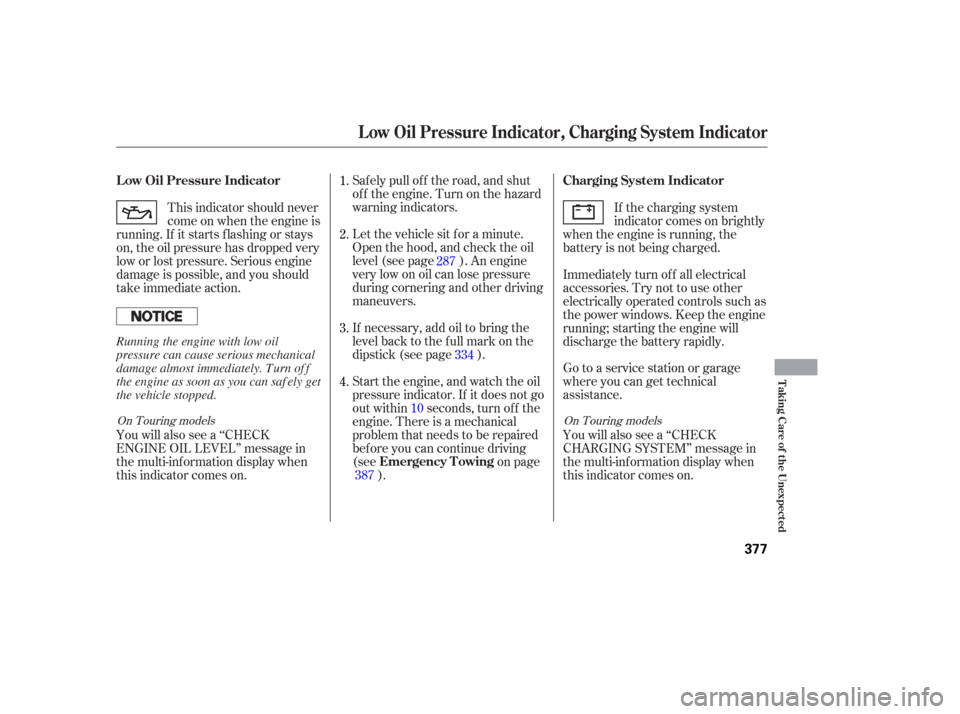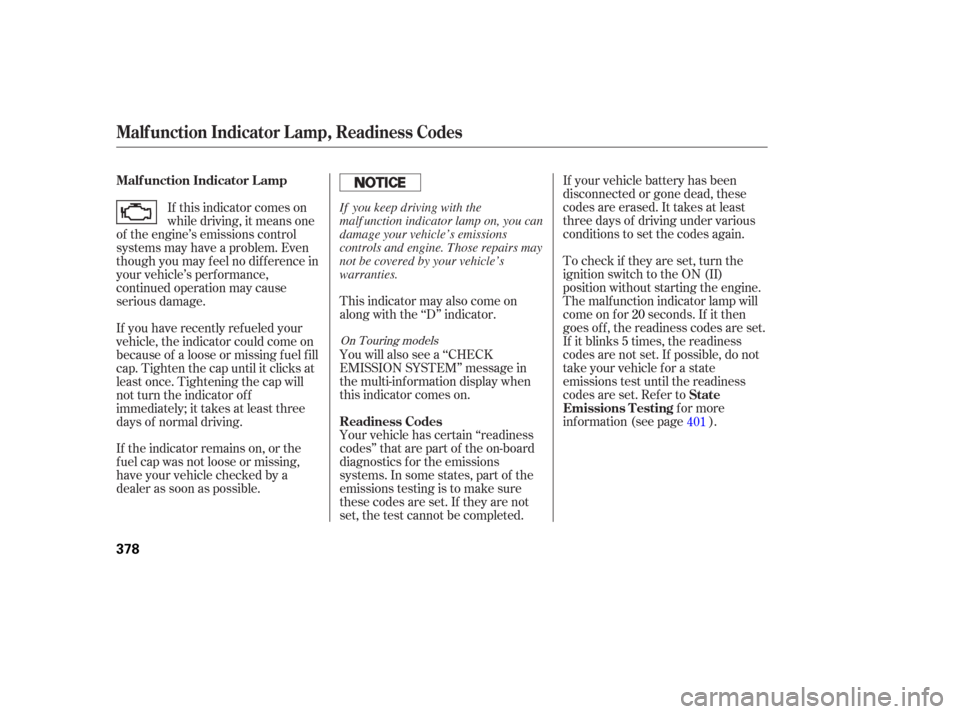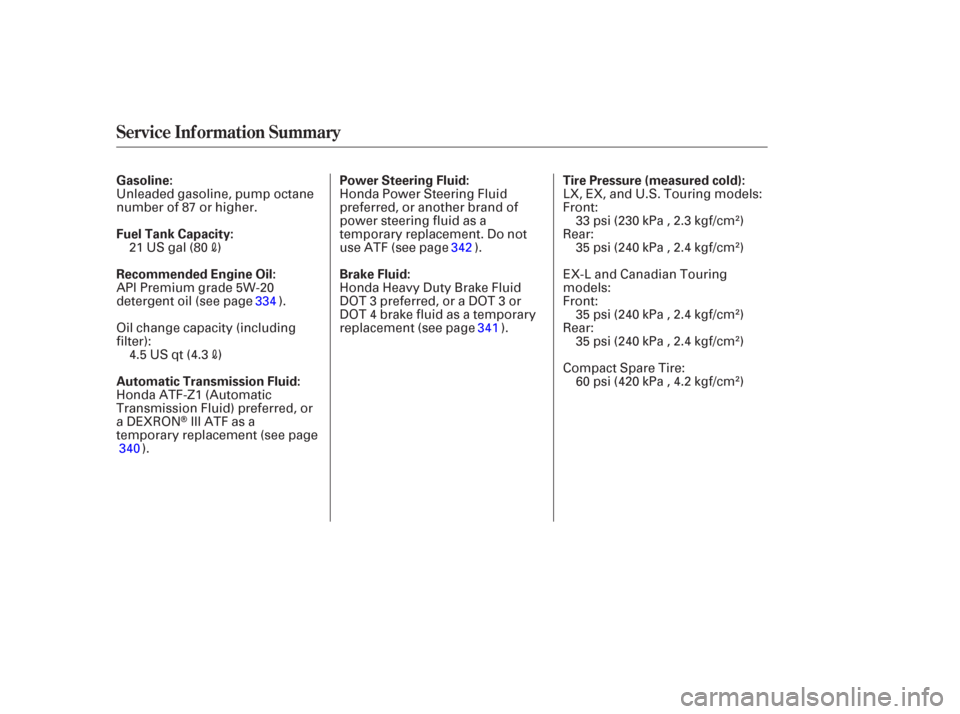Page 378 of 420

Saf ely pull of f the road, and shut
of f the engine. Turn on the hazard
warning indicators.
Let the vehicle sit f or a minute.
Open the hood, and check the oil
level (see page ). An engine
very low on oil can lose pressure
during cornering and other driving
maneuvers.
If necessary, add oil to bring the
level back to the full mark on the
dipstick (see page ).
Start the engine, and watch the oil
pressure indicator. If it does not go
out within10seconds, turn of f the
engine. There is a mechanical
problem that needs to be repaired
bef ore you can continue driving
(see on page
).
You will also see a ‘‘CHECK
ENGINE OIL LEVEL’’ message in
the multi-information display when
this indicator comes on. This indicator should never
come on when the engine is
running. If it starts f lashing or stays
on, the oil pressure has dropped very
low or lost pressure. Serious engine
damage is possible, and you should
take immediate action.
You will also see a ‘‘CHECK
CHARGING SYSTEM’’ message in
the multi-information display when
this indicator comes on. Go to a service station or garage
where you can get technical
assistance. Immediately turn of f all electrical
accessories. Try not to use other
electrically operated controls such as
the power windows. Keep the engine
running; starting the engine will
discharge the battery rapidly.If the charging system
indicator comes on brightly
when the engine is running, the
battery is not being charged.
1.
2.
3.
4. 287
334
387
On Touring models On Touring models
L ow Oil Pressure Indicator
Emergency T owingCharging System Indicator
L ow Oil Pressure Indicator, Charging System Indicator
T aking Care of t he Unexpect ed
377
Running the engine with low oil
pressure can cause serious mechanical
damage almost immediately. Turn of f
the engine as soon as you can saf ely get
the vehicle stopped.
Page 379 of 420

This indicator may also come on
along with the ‘‘D’’ indicator.If your vehicle battery has been
disconnected or gone dead, these
codes are erased. It takes at least
three days of driving under various
conditions to set the codes again.
You will also see a ‘‘CHECK
EMISSION SYSTEM’’ message in
the multi-information display when
this indicator comes on.
Your vehicle has certain ‘‘readiness
codes’’ that are part of the on-board
diagnostics f or the emissions
systems. In some states, part of the
emissions testing is to make sure
these codes are set. If they are not
set, the test cannot be completed. To check if they are set, turn the
ignition switch to the ON (II)
position without starting the engine.
The malf unction indicator lamp will
come on f or
20seconds. If it then
goes of f , the readiness codes are set.
If it blinks 5times, the readiness
codes are not set. If possible, do not
take your vehicle for a state
emissions test until the readiness
codes are set. Ref er to for more
inf ormation (see page ).
If the indicator remains on, or the
f uel cap was not loose or missing,
have your vehicle checked by a
dealer as soon as possible. If this indicator comes on
while driving, it means one
of the engine’s emissions control
systems may have a problem. Even
though you may f eel no dif f erence in
your vehicle’s perf ormance,
continued operation may cause
serious damage.
If you have recently ref ueled your
vehicle, the indicator could come on
because of a loose or missing f uel f ill
cap. Tighten the cap until it clicks at
least once. Tightening the cap will
not turn the indicator of f
immediately; it takes at least three
days of normal driving. 401
On Touring models
Readiness Codes
Malf unction Indicator L amp
State
Emissions T esting
Malf unction Indicator L amp, Readiness Codes
378
If you keep driving with the
malf unction indicator lamp on, you can
damage your vehicle’s emissions
controls and engine. Those repairs may
not be covered by your vehicle’s
warranties.
Page 420 of 420

Service Inf ormation Summary
Gasoline:
Fuel Tank Capacity:
Recommended Engine Oil:
Automatic Transmission Fluid:Power Steering Fluid:
Brake Fluid:
Tire Pressure (measured cold):
Unleaded gasoline, pump octane
number of 87 or higher.
API Premium grade 5W-20
detergent oil (see page ).
Oil change capacity (including
filter):
Honda ATF-Z1 (Automatic
Transmission Fluid) preferred, or
aDEXRON
III ATF as a
temporary replacement (see page ). Honda Power Steering Fluid
preferred, or another brand of
power steering fluid as a
temporary replacement. Do not
use ATF (see page ).
Honda Heavy Duty Brake Fluid
DOT 3 preferred, or a DOT 3 or
DOT 4 brake fluid as a temporary
replacement (see page ).
35 psi (240 kPa , 2.4 kgf/cm
)
Rear: 33 psi (230 kPa , 2.3 kgf/cm
)
Front:
Front:
35 psi (240 kPa , 2.4 kgf/cm
)
Rear: 35 psi (240 kPa , 2.4 kgf/cm
)
Compact Spare Tire: 60 psi (420 kPa , 4.2 kgf/cm
)
4.5 US qt (4.3
) LX, EX, and U.S. Touring models:
21 US gal (80
) 334
340 342
341 EX-L and Canadian Touring
models: